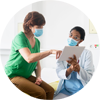Silica Update: Addressing Tighter Exposure Limits
In this webinar, you will learn about:
- The general and maritime industry update to the silica standard
- Why this update is occurring
- Recent research on occupational silica exposure
- Why medical surveillance is vital
- What to expect from your medical evaluations at Concentra
- Q and A
Presented by:
Ronda McCarthy, MD, MPH, FACOEM, national director of medical surveillance services
Melissa Hay-Boggs, director of product development
Host
0:00
Today’s webinar will be presented by Concentra's National Medical Director of Medical Surveillance. ”Today’s webinar will be presented by Concentra's National Medical Director of Medical Surveillance Services Dr. Ronda McCarthy and Concentra’s Director of Product Development Melissa Hay-Boggs.
At the conclusion of the presentation, we will have a 10-to-15-minute Q and A session with the presenters. You can submit your questions throughout the presentation to be answered during the Q and A. We will answer as many questions as possible within the time allowed. A recording of the webinar will be e-mailed to you after the presentation, so you can listen to it again at your convenience. Melissa, Dr. McCarthy. we're ready to begin.
Dr. Ronda McCarthy
0:41
Thank you. My name is Ronda McCarthy. I am Concentra’s national director of medical surveillance services. I’ve been with Concentra for approximately 20 years. For many of these years, I've consulted directly with employers on their occupational health programs, which include exposures to toxic and hazardous substances. I also chair Concentra’s Regulatory Testing and Exams Medical Expert Panel. Melissa Hay-Boggs is director of product development and is also a member of the Regulatory Testing and Exams Medical Expert Panel.
When the final updated silica rule went into effect, together we created Concentra’s Silica Medical Evaluation Services to provide OSHA-compliant examinations and testing and made it available to employees in all Concentra markets.
Today, we will discuss the June 23rd general and maritime industries’ update to the silica standard and why it's occurring. We will also look at the current research on silica exposure and how we can apply the findings. This leads us to why medical surveillance is vital, and what you should expect from your occupational health provider. I will hand it over to Melissa to get us started. Thank you.
Melissa Hay-Boggs
2:02
Hello. I'm Melissa Hay-Boggs. Dr. McCarthy and I have been working together for quite some time, specifically around silica medical surveillance, and many different exposures. We've had the opportunity to present a couple of different times throughout the years, but I'm sure not all of you have had the chance to listen in on those previous webinars. So, before we get too deep into the content, we thought it would be a good idea to review what crystalline silica is and why it is harmful to employees. So, really, I want to level set with everyone and define crystalline silica.
What is crystalline silica?
Crystalline silica is a basic component of soil, sand, granite, and other minerals. Quartz is actually the most common form of silica. Several industries that typically work with this mineral include, glassmaking, stone manufacturing or manufacturing with stone, creating china or ceramics. If you're working in a foundry, you might be exposed to silica, working with concrete. If you're in the mining industry or construction, especially in working with artificial stone, and you can even find it in jewelry manufacturing.
Some of our construction activities and even municipalities will experience silica exposures by working with asphalt and pavement. Dental laboratories also will come in contact with silica. Finally, there are several household adhesives and abrasive materials that, in manufacturing, also produce harmful crystalline silica.
3:56
In and of itself, silica is not actually harmful. If you're handling it in its natural state, you know, one of those minerals that we just spoke about, it's not harmful to employees. What happens is when you're working with that particular material and the material becomes respirable, that's when you start to worry about the effects on your employee.
The amount of crystalline silica in natural stone actually varies quite widely. For example, in sandstone you'll see 70-to-90 percent. In granite, 30 percent crystalline silica, whereas lime and marble contain only 2 percent. Of note here, I want to make sure everyone understands that things like artificial stone actually contain as much as 93 percent crystalline silica.
So, when does crystalline silica become harmful? That occurs when it's made respirable or essentially small enough to breathe deep into the lungs, for example, when it’s used in high-impact processes such as abrasive blasting, drilling, cutting, and sanding. It is that respirable form that is actually covered by the OSHA standard regarding respirable crystalline silica.
5:29
The road to the silica standard has been quite a long one. This is not unusual. It can take 15 years or so to complete OSHA's rulemaking process. Initially, standards were set to limit employees’ exposure to silica in 1971, when OSHA was created. The silica rulemaking process became a priority in 1990, when it was determined the standards were outdated and did not adequately protect employees from the health-related effects from silica. It was not until 2016 that the updated silica standard was finalized. The silica standard for both construction and general and maritime industries’ rules became effective over time. The graduated process occurred to make it economically feasible for companies to adjust over time.
Requirements for engineering controls, those measures that may call for an investment in new tools, new equipment, machinery, and ventilation, for example – those cost quite a bit, and companies needed an opportunity to adjust to those costs and implement those controls.
Hydraulic fracturing in oil and gas was not required to implement controls to keep exposure below PEL, the permissible exposure limit, because they're getting time to develop the controls for this new industry. So, in these ways, it does take a lot of time to develop the standard and then allow companies to adopt and implement the controls that they need to have in place to protect their employees from exposure.
Dr. McCarthy, do you want to talk through the specifics of what’s tightening on these controls and what the health effects are to employees?
Dr. Ronda McCarthy
7:27
Sure. What's bringing us together today is basically that, as of yesterday, June 23rd, general and maritime industry employers are now required to offer medical surveillance exams at action levels. The silica standard for general industry and the maritime industry specifically has implemented this phased approach that Melissa discussed.
Phasing in a more stringent requirement
In 2018, medical surveillance was required based on a higher permissible exposure limit (PEL) for both general and construction industry. But, now the standard has invoked a more stringent action level requirement for medical surveillance. This is for employees specifically exposed or expected to be exposed at or above action level for 30 or more days per year. The goal of medical surveillance evaluations performed at a reduced exposure level is early detection of silica-related illness, and also to provide feedback on the effectiveness of existing controls.
Approximately 2.3 million employees are exposed to respirable crystalline silica or silica dust in the US in construction and general industries. The silica standard limits the amount of silica exposure that employees can be exposed to at the workplace and provides employers regulations on how best to attain these limits. The overarching purpose of the regulations is to prevent serious disease and death. It is well-known that employees suffer health effects from long-term exposure at lower concentrations of silica. But there's also an equivalent with short-duration/high-concentration exposure to silica, and it can have three times the damaging health effect on employees. Work that has high concentration exposure, such as abrasive blasting and artificial stone fabrication have now been noted to have effects that we're going to talk about today.
Health effects of silica exposure
10:00
What are the health effects of silica exposure? Silicosis is an incurable lung disease that is caused by inhaling respirable particles of crystalline silica. These particles trigger inflammation and scarring in the lungs, leading to a progressive, irreversible, and potentially disabling disease.
Silica exposure also is associated with increased risk for lung infection, most notably, tuberculosis, lung cancer, chronic obstructive pulmonary disease or COPD, autoimmune disorders, and kidney disease.
Let's cover the current research on silicosis and other silica-related disease and what we can take away from these findings, such as the high exposures that employees have been exposed to in some of these newer industries. Some of the recent changes in the past few years that may have contributed to new information on silica exposure include the medical screening for specific employee populations that OSHA has mandated since 2017 and the engineered or artificial stone and hydraulic fracturing industries that are newer for the United States and are expanding quickly due to the increased demand. Research was published just last week in the journal Chest® pertaining to silica exposure.
New research on silica exposure
11:36
The lead investigator reported on a cohort of employees or a group of employees from the engineered stone fabricating industry. These employees fabricated and installed quartz countertops. Most of the silica cases were referred from the employees after they were referred to specialists and had more advanced disease. Of great significance, all of these patients had already been removed from continued exposure. One-third of the patients initially had simple silicosis and after removal, on average of a four-year follow-up, had advanced to progressive, massive fibrosis. It’s a severe, debilitating silicosis. Employees who were removed from exposure due to abnormal breathing studies, in approximately the same average four-year follow-up, their breathing studies had worsened; they were almost doubly worse in their breathing abnormalities. High rates of progression are in contrast to the lower percentages of disease progression seen in miners and granite workers from the past where, in one study, there was only a 10 percent progression to the severe lung disease over a 22-year period. So, here you have, in these new industries, employees have pretty significant disease, and then even after a four-year follow-up, they have an even more severe disease during a very short period of time. The author states that aggressive medical surveillance should be instituted for this workforce.
13:41
Another research report on severe silicosis in the Morbidity and Mortality Weekly Report looked at engineered stone fabrication employees from four states. I'm actually an author on this report. I evaluated and diagnosed the Texas cases. This report highlights younger employees found with serious lung disease. The disease developed early, in employees who had two to 30 years of exposure. The affected employees were in their thirties to fifties. Previously, among engineered stone fabrication workers, only one US case was reported prior to this report in the late 2019.
Not only did they suffer from silicosis in this report of 18 cases from four states, the employees also had autoimmune disorders and tuberculosis. One case had tuberculosis. One of the deaths was from an autoimmune disorder but was also diagnosed with silicosis. The issue is that the popularity of artificial stone is growing rapidly, and this problem needs to be addressed. This is just an example of the severe health-related effects that silica causes but in a subtle fashion because of the high exposure.
It was also found that, unfortunately, most of the reported cases of artificial stone-associated silicosis were not detected by medical surveillance in these at-risk populations. Rather, they were employees who were referred to specialists and transplant centers who presented with advanced diseases. Employees are hesitant to report illness and do not necessarily seek medical attention until their disease is severe. Some of the reasons we are seeing low levels of reporting are lack of employment opportunities for these employees, diminished access to healthcare in general, fear of retaliation on the side of the employer.
Reluctance to report ill-effects
I have evaluated silica-exposed employees who did not want to report disease over the past several years. These employees have become more concerned about providing for their families than for their health. But now, with increased awareness of the dangers of silica, it is wise for employers to aggressively approach control measures and medical screening to prevent this costly illness and injury in the workplace. Exposure monitoring must be done and those values heeded. Education and training are essential for supervisors and employees. Proper use of controls and respirators should be required. For example, wet sweeping may be available at a work site, but it doesn't decrease the exposure if the employees aren't using it because it saves time for them to use the older method. Or a tight-fitting respirator will not work as intended if the employee has a full beard. I’ve seen this situation many times.
Training on silicosis will also help employees understand the health effects and when to report symptoms, as well as the importance of medical screening that's offered. Most people who are affected by silica do not have symptoms of health effects until the disease is severe. This makes it more costly for the employers in work illness and workers' compensation costs.
Why medical surveillance is vital
17:52
So, why is medical surveillance so vital? Exactly for the reasons stated and because silica-related health effects are entirely preventable with use of the hazard controls that are outlined in the OSHA standards. You can even go above and beyond. It calls for exposure monitoring, outlines exposure controls, and medical surveillance. The medical surveillance for baseline screening is to assess the health of the employee prior to silica dust exposure. You do not want to put someone who has underlying health conditions that may make them more sensitive to the health effects of respirable crystalline silica.
Also, screening helps detect early health effects, so you can discuss with the employee how to best manage the health effects before it becomes a disabling disease. They can have restrictions, have better PPE or be moved to a different area of the plant or different work entirely so they can maintain their health. Provide respirator restrictions. There may be some employees who may be exposed at a level that doesn't require a respirator. Some may not be able to use a respirator adequately and need alternatives. Medical surveillance also is a feedback mechanism to provide the employer information on the effectiveness of existing controls. If you have groups of employees coming down with ill-health effects, that lets you know that your engineering and administrative controls need to be addressed and changed.
Hierarchy of controls
The National Institute of Occupational Safety and Health (NIOSH) defines the rungs of protection for all hazardous exposures in the hierarchy controls where you go from the most effective to the least effective down on the bottom of the triangle here. The elimination of the hazard would be the best control. Substituting to a less hazardous substance would be the next. Where we spend most of our time regarding the OSHA silica standard is in engineering and administrative controls. PPE, the respirator, is the least effective. Medical surveillance and medical screening help back up the engineering, administrative and worksite controls, and can actually act as primary prevention when used as a feedback mechanism, as we discussed.
Medical surveillance exam components
20:48
Let’s look at the specifics of the exam for medical surveillance. This may just be a review for some and new for others, if you are now having to provide medical surveillance exams for the first time, now that the ruling has gone down to action level. The baseline and periodic exams are very similar. You have a medical and occupational history and physical exam focused on the respiratory and immune system. Then you also have spirometry that must be administered by a technician who is certified by a NIOSH-approved spirometry course. That is part of the standard. A chest x-ray, one view with a specialist overread that helps look for changes related to silica exposure, pneumoconiosis specifically, and then, also, tuberculosis screening at baseline. The periodic exam does not have the tuberculosis screening. There are also recommended tests that can be added. So the OSHA requirements are the minimum requirements for general and construction industry. But there can be additional testing, either based on the employee's history and exam – testing that the clinician may advise – or additional testing that the employer would like to add for more thorough screening, such as kidney function testing, since the kidneys can be affected, and additional tuberculosis screening, since there is an increased risk, especially after years of exposure.
Importance of respirator fit and function
22:31
Respirator medical clearance is a separate medical evaluation that is covered under the respirator protection standard. But you can add it to the silica medical evaluation as they have overlapping examination components. By performing both of these at the same time, the employer can reduce employees’ time away from work and reduce the overall costs of these services. It may be that the employer wants to perform the respirator medical evaluation, or clearance exam, prior to the silica medical surveillance, to make sure the employee is fit to wear a respirator prior to putting them into a silica-exposed job to ensure that they are able to wear a respirator if that's part of the requirement. So, that's an alternative way to proceed, as well.
But I'd like to advise that it's important to make sure that respirators fit well. Even with training and fit testing, I've often seen, when touring a plant, that many employees’ respirators may not fit well. They may have facial hair that's interfering with the seal. It's important to inspect the respirators regularly and replace them when damaged. Also, OSHA requires that fit tests be done annually. If a respirator does not fit well or has been damaged, it's not doing the work that it was meant to do and could be causing additional exposure for the employee.
After the examination, additional requirements of the silica standard are written reports to the employer and the employee. There are three forms that are required to complete after the silica medical screening exam. The employer written medical opinion, the employee written statement, and the authorization of the employee to provide an opinion to the employer.
24:49
The information in the employer written medical opinion is limited to the date of the exam, if the standard was met, the medical evaluation that was required by this standard, and if there are any respirator restrictions. Concentra’s systems automatically print out all of these OSHA-compliant forms that are that are provided to both the employer and the employee. A written medical opinion for respirator use, if requested, is also provided, if this differs from the silica written medical opinion. The authorization for crystalline silica opinion to the employer provides additional information if the employee consents, and this is limited to exposure, whether there will be limitations on the employee's exposure to silica and whether the employee consents to referral to a specialist, if applicable. The standard requires referral to a board certified pulmonary specialist or occupational medicine specialist if there are specific findings on the B-read of the chest x-ray, But the employee can decide not to choose those options and make their own health decisions. And then the employer's not responsible for that if they choose not to sign that authorization form.
So, Melissa, these reports are then sent to the employer once completed, and they should be received in 30 days after the evaluation. We have a process for that, as well. Are there any other thoughts that the employer should consider?
Melissa Hay-Boggs
26:38
Yes, there are. I want to cover a couple of things that you can expect from Concentra, as well as things you should look for from any occupational health provider to make sure you're getting quality services regarding medical surveillance. One of the things is that you want to make sure your health provider can advise you, specifically, on federal and state regulations around OSHA requirements. You want somebody who is educated and attuned to any changes to make sure that you're going to be in compliance, in case you ever get audited. You want to make sure that they're aware of the federal and state laws and that they know exactly what components are required. In the case of silica, that means the kinds of technicians who have to have specialized training to be able to perform some of the tests that are involved in the exam.
Another thing that you should be looking for are clinicians who understand the intersection between workplace health and the regulations, as well as the employer’s challenges in fulfilling all the requirements. Our Regulatory Testing and Exams Medical Expert Panel is continually reviewing the rule and making sure that our clinical guidelines are exactly what they need to be to meet the requirements but aren’t going to be going beyond the testing that is actually required.
We do make recommendations based on the health effects of what different exposures can cause with employees, just so that you have the opportunity to review those additional tests and potentially get in front of issues that can develop over time. But we're not going to do a full suite of tests that aren't specifically required or related to the regulations, without consent from the employer. You should look for an occupational health provider that can pay attention to those things and keep the best interests of the employee and the company in mind. That's where the expertise comes in of understanding what occupational health is and applying health care specific to what's happening with that person at the place of their employment. This way, you can expect to receive or to obtain reduced direct costs and indirect costs.
As an example, Dr. McCarthy spoke of how there are overlapping components between respirator clearance and medical surveillance. Combining those two services in a single exam helps cut out repeated tests and makes sure that you only have to send your employee one time versus two times. We know that all of those things matter, specifically to our customers.
So, those are some of the things that you really should be expecting from your occupational health provider, in addition to the specifics around silica, which include the written medical opinion reporting, the specific documents being in compliance with OSHA regulations, and the communication of those written medical opinions to you as the employer so that you can make sure you have the records and the information necessary to maintain your program at your place of work.
So, at this time, we have covered quite a bit. I'd like to turn it over to Anna to facilitate some Q and A.





